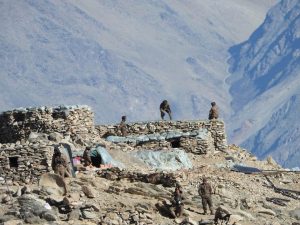The China-India standoff in eastern Ladakh shows signs of ending after almost 10 months. Arguably the most serious in over half a century, the standoff – involving multiple points of Chinese incursions across a large frontage – at times threatened to erupt into war. Beyond a mid-June clash between Chinese and Indian forces in the Galwan Valley, an Indian military operation at the end of August to seize unoccupied peaks in the Kailash range saw the country deploy the secretive Special Frontier Force. Both sides used firearms ostensibly to warn each other and signal resolve.
The standoff also saw China and India field an unprecedented number of soldiers (about five divisions each, according to media reports) as well as armored columns, missiles, air assets, and other weapons and platforms along the Line of Actual Control (LAC) in Ladakh, dramatically raising the risk of escalation. However, since February 10 both Chinese and Indian forces have disengaged at two of the critical friction points around the scenic Pangong Lake, and both countries have committed to working to resolve the crisis elsewhere.
Retired Lieutenant General D.S. Hooda is no stranger to the LAC, having headed the Indian Army’s Northern Command (responsible for the Ladakh sector, among other, contiguous, areas of responsibility) between 2014 and 2016. Since retiring from the military in November 2016, Hooda has been involved in a range of think tank and advisory activities around Indian strategic affairs. In an interview with The Diplomat, Hooda distills the key lessons he has drawn from the Ladakh standoff and how he sees the future unfolding as India renews focus on its northern boundary.
The Indian government had maintained, first, that it wasn’t sure why the People’s Liberation Army (PLA) did what it did, and then, that the explanations provided by Beijing for its actions were not “credible.” In your personal assessment, what could have been China’s motivations behind the standoff? To what extent are hypotheses that it was the result of India’s August 2019 Jammu and Kashmir decisions, or its push toward improving infrastructure along the LAC, credible?
China’s military actions indeed came as a matter of great surprise to India. In attempting to analyse China’s motivations, two things are clear. First, there was no immediate provocation that could have served as a trigger for the Chinese intrusion. Second, the Chinese plan was at least a few months in the making as the first reports of a major military exercise in Tibet had come out in January 2020. Soldiers from that exercise were diverted for the transgressions in May. Therefore, we could assume that it was a series of events from the August 2019 decision and subsequent comments made regarding Aksai Chin, India’s opposition to the Belt and Road Initiative, and the growing closeness in U.S.-India ties, that possibly prompted the Chinese leadership to attempt military coercion of India. I also think that China seriously underestimated Indian resolve not to buckle under their threat.
































